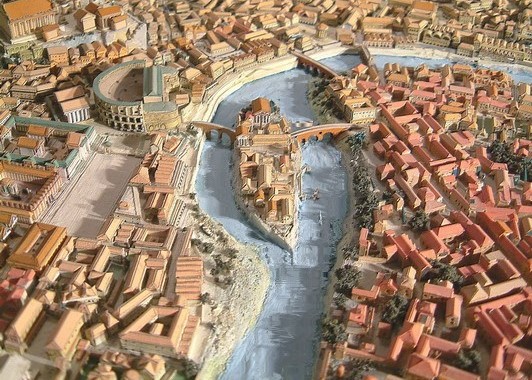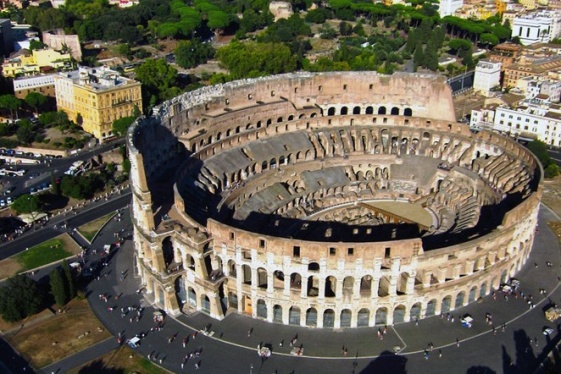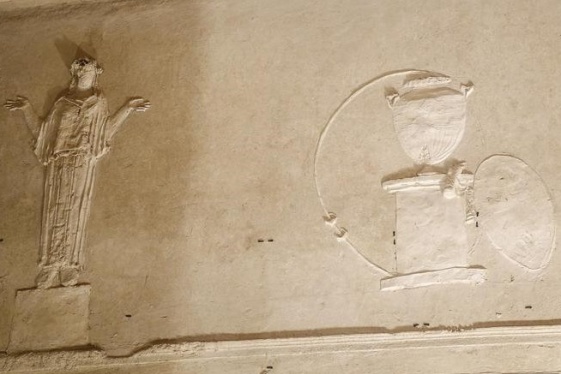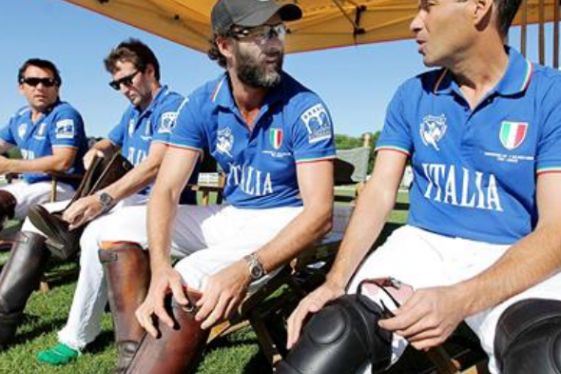

The Isola Tiberina, located in the middle of the Tiber, right in the center of Rome, is a real monument in that in ancient times it had been worked and decorated in the shape of a ship. A real and gigantic Roman vessel with its mast, at that time an obelisk, that seemed to sail on the Tiber. Isola Tiberina is the only urban island on the Tiber in the center of Rome. The island is connected to the two banks of the Tiber by Ponte Cestio and Ponte Fabricio.
About 300 meters long and 90 meters wide, it houses a real suburb with churches, hospitals, bars, restaurants, and several houses, right in the center of Rome and in the middle of the Tiber River. Legend has it that the island was formed in 510 B.C. from sheaves of wheat harvested in Campo Marzio, owned by King Tarquin the Superb at the time of the revolt: studies, however, prove that the island has origins long before the event.
It housed the temple of Aesculapius, god of medicine, whose cult was introduced in 292 BC following a plague.
In the first half of the first century BC it was monumentalized in opus quadratum, parallel to the construction of the Fabricius and Cestius bridges. At that time it took the form of a ship, the prow of which is still visible today, with travertine blocks lining the peperino interior, and some decorations depicting Aesculapius with his serpent and a bull's head, probably used for moorings.
One legend has it that the island had actually risen on the remains of a ship that sank there. For this very reason it was rearranged like a ship, the sides were covered with travertine and the bow and stern of a ship were simulated on one side. Little remains today of this rearrangement
Always an island of the sick, probably because of its location Tiber Island was also used for quarantines.
The Temple of Aesculapius was inaugurated in 289 BC and stood in the southern part of the island, on the site now occupied by the church of St. Bartholomew. On either side of the temple was a portico for the reception of pilgrims and the sick. In the northern part were a number of small shrines related to particular cults, now located among the foundations of Fatebenefratelli Hospital. The church of San Giovanni Calibita is also located on the island.
The island is almost certainly of sedimentary origin, and legend has it that it was formed by the accumulation of mud on Tarquinio il Superbo's harvests thrown into the Tiber by the Romans after his ouster in 509 BC.
In 291 B.C., to eradicate the plague two years earlier, the snake sacred to the god of medicine Aesculapius was brought to Rome from Epidaurus: after landing, it jumped from the ship carrying it and descended the Tiber from the Navalia of the Campus Martius to the island, disappearing later at the site where the new temple was built.
The legend and profile of the island suggested the arrangement of the outer perimeter of the island in the form of a ship, with embankments and embankment equipped for moorings and perhaps with an obelisk to simulate the mast. This symbolic vision of the ship-island would influence cartography and depictions of the island over time to the present day.
The only surviving elements are fragments on the southeastern tip of the island in peperino and travertine depicting Aesculapius with a caduceus and a bull's head, which probably served as a mooring.
Two fragments of the obelisk that was believed to be the ship's mast are preserved in the National Museum in Naples and a third in Munich. Although represented in many prints, it is the current opinion that the mast never existed and that the eventual erection of an obelisk on the island occurred later as a simple ornament.
As for orientation, does the stone ship go up the river or down it toward the mouth? There is still no unanimous agreement among scholars regarding the orientation of the ship; these are the main reasons supporting the two theses: either the ship is oriented toward the northwest and is ascending the river, or the ship is oriented toward the southeast and is sailing toward the sea.
You may be interested
-
Exciting Palatine. Interview with Clementina...
You can tell she fills with excitement when she has the chance to show an important archae...
-
Italian Open's History and Records: A tale o...
For Italians, and Romans in particular, the Open is not just a tennis tournament where cha...
-
'Basilica of Mysteries' reborn in Rome
The so-called 'Basilica of the Mysteries' has been reborn in Rome. The basilica, one of th...
-
'Carbonara Day' celebrates famous pasta dish
On Friday, April 6, the world will celebrate "Carbonara Day", an occasion launched by the...
-
'Gladiators' bring Roman flavor to R.I. polo
As thousands of sharply dressed spectators converged on the turf of Newport International...
-
'Hot priests' grace Rome's calendar
It is officially called the Calendario Romano, or Roman Calendar. But on the streets of Ro...
-
'No one should be left behind': Italian teen...
A 15-year-old boy, known as Simone, has become an overnight internet sensation after stand...









